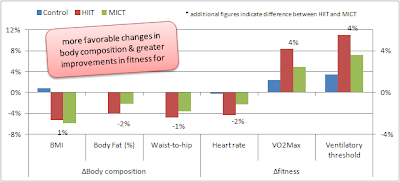Are You Still Burning Calories or Already Losing Fat? Study Shows: 5x15 Min HIIT Reduce Body Fat & Improve Fitness Twice as Effectively as 5x40min of Classic Cardio
 |
| Image 1: The number of women striving to be strong & sexy is still too skinny. |
"But didn't they lose more weight with classic cardio!"
What happens if you take 60 female overweight (BMI>25kg/m² and body fat >30%) university students and tell them they got to lose weight? Well, I guess, 45 will run to the next best newsdealer get their Shape, let alone Cosmopolitan and start starving themselves according to the latest diet fat from Hollywood, while the remainder will do just the same, except that they combine the starving with some "healthy" cardiovascular exercise in the mythical "fat burning zone". Now the former, i.e. the starvation diet, was not an option for any of the 60 Chinese women, as the design of the 12-week trial required them to maintain their regular diets, the latter, and even the walking or running in the "fat burning zone" was not really part of the experimental conditions the women were randomly assigned to:
- moderate intensity continuous training (MICT): 40min of jogging or walking at 50% of the individual VO2max
- high intensity interval training (HIIT): 5x3min of running at 85%VO2max with 3min of active rest between the high intensity bouts
- sedentary control: no exercise at all
 |
| Figure 1: Changes in body composition and fitness parameters compared to baseline (Sijie. 2012) |
Not just for Chinese overweight women: Another recently published study by Astorino et al. confirms that the HIIT induced beneficial effects on VO2max are not restricted to otherwise sedentary, obese subjects, but will also occur in active, young men and women (age and body fat = 25.3 ± 4.5 years and 14.3 ± 6.4%). And that despite the fact that the subjects in the Astorino study performed only two sessions per week (4-6x 30s wingate tests = all out cycling followed by 5min active recovery) and the total duration of the study was no longer than three weeks (Astorino. 2012). In this context it is also worth mentioning that Ciolac et al. were able to show that young women with high familial risk for hypertension also derive greater benefits in terms of cardiovascular health improvements from aerobic interval vs. classic aerobic training (Ciolac. 2011).
Lose weight or lose fat? Look sick or look good? Burn calories or burn body fat? LISS or HIIT?
Despite all obvious limitations of this study it should thus be obvious that "cardio", regardless of whether you do it to improve your physique or overall fitness, must neither be time consuming nor should it be conducted in the "fat burning zone". Those of you who have been following the Step By Step Guide to Your Own Workout (specifically the Fat Loss Example Routine), will yet be aware that this does not imply that you must never perform "classic" low intensity steady state cardio. As a means of recreational activity on your off days, 20-30 minutes on a treadmill may actually help you recover from the "real" training sessions which will bring about those adaptation (fat loss and muscle gain) even women should be striving for if their focus is to improve the way they look and feel about their bodies.
A note on the right type of HIIT for you: If you compare the HIIT protocol in the Astorino to the HIIT protocol in the Sije study, it is pretty obvious that we are dealing with an all-out short burst approach (Astorino) vs. an high intensity longer burst approach (Sijie). In order to find the right HIIT protocol for you, you will have to reconsider your current training status and goals - with the general rule being: The fitter you are the more you should tend towards the shorter all-out bursts, because here, outside your comfort zone, is where the magic of adaptation happens. The more body fat you are still carrying, the more you should tend to longer high intensity bouts.
References:
- Astorino TA, Allen RP, Roberson DW, Jurancich M. Effect of high-intensity interval training on cardiovascular function, VO2max, and muscular force. J Strength Cond Res. 2012 Jan;26(1):138-45
- Ciolac EG, Bocchi EA, Greve JM, Guimarães GV. Heart rate response to exercise and cardiorespiratory fitness of young women at high familial risk for hypertension: effects of interval vs continuous training. Eur J Cardiovasc Prev Rehabil. 2011 Dec;18(6):824-30. Epub 2011 Feb 28.
- Sijie T, Hainai Y, Fengying Y, Jianxiong W. High intensity interval exercise training in overweight young women. J Sports Med Phys Fitness. 2012 Jun;52(3):255-62.


